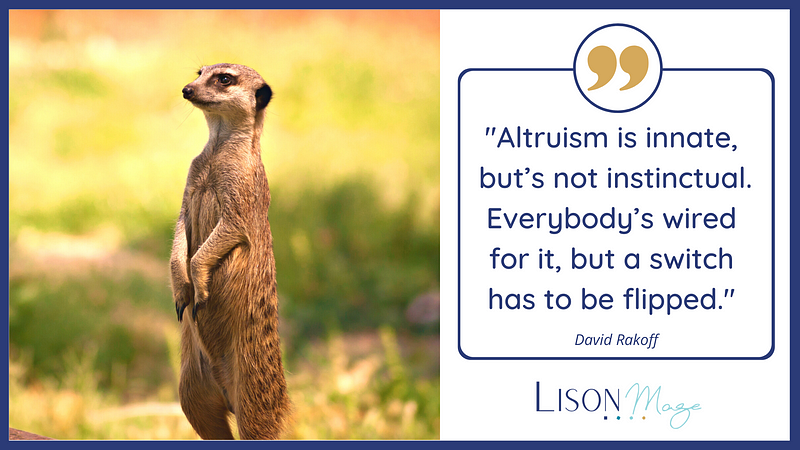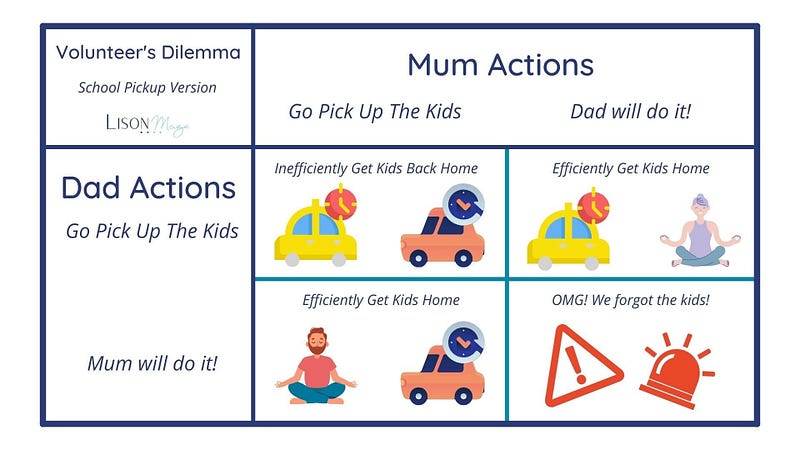Becoming an Altruistic Leader: Lessons from Nature and Life
Written on
Chapter 1: Insights from Meerkats
Have you ever heard of meerkats? These small mammals, closely related to mongooses and smaller than house cats, are known for their remarkable teamwork. Living in groups, they share responsibilities such as caring for their young, prioritizing the welfare of their entire community.
To safeguard against potential threats, meerkats take turns acting as sentinels, standing watch while others focus on their tasks. When they detect danger, the sentinel emits a specific alert call, giving the group a chance to hide while risking their own safety. Interestingly, these guardians take on this perilous role voluntarily, displaying a remarkable sense of altruism¹.

Chapter 2: The Volunteer’s Dilemma
This behavior can be linked to the concept of the Volunteer’s Dilemma, explored in game theory, which analyzes decision-making scenarios. This theory addresses the idea of negative coordination, where individuals must make sacrifices to resolve an issue, but if no one steps forward, everyone suffers.
Real-life examples of this dilemma can range from heroic acts to everyday decisions, such as who will contact the electricity provider during a blackout or who will pick up the children from school. For a parent, making the trip to school requires a commitment of time and resources, and while it may be inefficient for both parents to go, the worst-case scenario is that neither does.

Chapter 3: The Role of Connection and Communication
Solving these dilemmas often hinges on connection and communication. Research shows that social proximity plays a significant role in motivating individuals to volunteer. The closer we feel to someone, the more likely we are to act altruistically².
For instance, if a manager sends an urgent email on a Friday night about changes to a client’s requirements, team members who feel a strong social bond are more inclined to volunteer for the task of revising the presentation. However, to avoid duplicating efforts, clear communication is essential. Keeping everyone updated ensures optimal outcomes for the group.
Interestingly, overthinking can complicate our responses to these dilemmas. For example, if we recognize consistent errors in company reports that management has not noticed, we may hesitate to speak up. We fear that our actions could lead to consequences for others or label us as whistleblowers.
The phenomenon known as the diffusion of responsibility often underlies this hesitation. We may think, "Why should I act when someone else might?" This mindset can lead to inaction, resulting in long-term regrets when we ponder the “what-ifs” of missed opportunities.

Chapter 4: Taking Action
In moments of uncertainty, it’s crucial to take action. Embrace the leader you aspire to be, countering inertia to foster change. Although it might feel awkward initially, your proactive efforts can illuminate the path for others and unite them behind your vision.
One common misconception about the Volunteer’s Dilemma is viewing it as a scenario where one person sacrifices for the benefit of others. Instead, it’s vital to recognize that our losses can also translate into collective gains. For example, by reporting a power outage, we invest time, but ultimately benefit from the restoration of service.
Additionally, our actions can create unseen ripples. Research indicates that witnessing acts of kindness, like blood donation, can inspire others to follow suit³. Thus, when faced with these dilemmas, we should reframe our perceived sacrifices as investments in our collective strength.
I hope you found this article enlightening! If you enjoyed it, consider reading “How to Evade the Prisoner’s Dilemma?” for further insights.
PS: If you're interested in collaborating with me on workshops for personal or professional development, click here to join my next session.
This video, "How to Raise an Altruistic Leader," explores strategies for fostering altruistic leadership in various settings.
In "LIFE 2015: Victoria Xi Wang - Altruistic Leadership," Victoria shares her insights on the principles of altruistic leadership and its impact on communities.
Source:
[1]- Clutton-Brock, T.H., et al., 1999, “Selfish sentinels in cooperative mammals,” Science.
[2]- Krueger, J. I., et al., 2016, “Expectations and decisions in the volunteer’s dilemma: Effects of social distance and social projection,” Frontiers in Psychology: Cognition.
[3]- Studte, S., et al., 2019, “Blood donors and their changing engagement in other prosocial behaviors,” Transfusion.